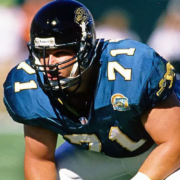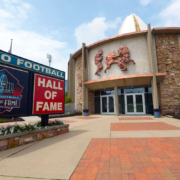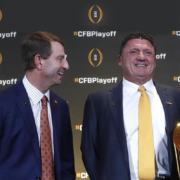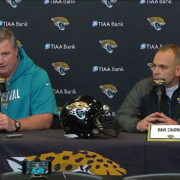Boselli’s Chance
This coming Saturday in Miami, former Jaguars Tackle Tony Boselli and Packers safety LeRoy Butler are among the 15 finalists for the remaining five spots in the Pro Football Hall of Fame’s “Centennial Class.” Recognizing the NFL’s 100th anniversary and the year 2020, the Hall expanded this year’s class to include 10 seniors, two coaches, three contributors and five modern-era candidates. Those modern-era candidates are the finalists we’ll talk about this Saturday, players whose careers ended less than twenty-five years ago.
A “Blue Ribbon” Committee was appointed to select the first fifteen members of the Centennial Class. The regular Selection Committee will discuss the final fifteen Saturday and whittle that group down to the final five for enshrinement in Canton with a little twist on the rules from previous years.
Normally the Selection Committee talks about players and coaches and the final five have to endure an up or down vote. Each has to get 80% of the Selection Committee’s endorsement to gain entrance into the Hall. This year the Committee will only talk about players and there will be no up or down vote. The final five will be part of the class.
It’s the fourth consecutive year Boselli has made the finalists list. It’s the first time Butler has made it “in the room.” Making it “in the room” gives a player about an 88% chance of eventually making it to the Hall.
Because it’s his fourth year in the final fifteen, Boselli has a better chance this year than Butler but I think both deserve enshrinement in Canton. I’ll give support to LeRoy’s candidacy during the meeting. He’s a four-time All-Pro and four times was elected to the Pro Bowl. He played on a Super Bowl championship team. He was on the NFL’s All-Decade team of the ‘90’s. He has a strong case for the Hall.
But it’s my job as the Jacksonville representative to present Tony’s case to the other forty-seven selectors. The Green Bay rep will present LeRoy’s case.
The Selection Committee is a group of reporters and two Hall of Fame members who are serious-minded, smart, experienced and well prepared. They’re not swayed by flowery rhetoric or great oratory skills. They’re interested in facts they might not have uncovered. They want to hear what the candidate’s contemporaries say about his qualifications, his teammates and opponents, players and coaches.
Boselli had been eligible for the Hall for eleven years before he became a finalist. Give credit to my colleague Vito Stellino, a Hall of Fame writer himself and an at-large member of the Selection Committee for jump-starting Tony’s candidacy. His off-season reminder to Committee members that Boselli’s career exceeded the length of some recent inductee’s gave Tony’s case an early push.
There’s really not much debate about the quality of Boselli’s play. Nobody disputes that at the peak of his performance, he was among the best, maybe in the top two of those who ever played tackle in the NFL. (The consensus is Anthony Munoz is the best tackle ever. Even Boselli thinks so.)
Players from Tony’s era who have made it to Canton all believe in his qualifications.
Munoz said he thinks Boselli “is one of the best offensive tackles I have observed.”
“He had the versatility of Gary Zimmerman and Walter Jones,” said John Randle, who Boselli calls his toughest opponent. “He was patient, that’s what makes the great ones I don’t see that much these days. Tony had great feet, he never got crossed over.”
Jason Taylor suffered a beat down in a nationally televised game and said recently, “ Tony Boselli wore me out! In fact, if they didn’t turn off the lights, he would still be kicking my a**. He belongs in that (Hall of Fame) box.”
Even Bruce Smith, previously reluctant to talk about his matchups with Boselli, endorsed him this week. “He was a stud. He gave me all I could handle. In that era of football, there was none better.”
Walter Jones was a few years older than Boselli but admitted he looked at Tony’s game tape each week to compare his own game.. You could call the era that included Jones and Boselli the “Golden Age of Tackles.” Orlando Pace, Jonathan Ogden and Willie Roaf were all in that time frame and all are in the Hall. All also admit Boselli might have been the best of the lot.
John Hannah, considered the best guard to ever play the game said, “When I watched Tony Boselli play I thought he was the best offensive tackle I ever saw.”
Boselli ranks either first or second among the tackles of his era when it comes to sacks per game, rushing yards to his side and most other quantifiable statistics. He was named All-Pro four times by different organizations and was five times selected to the Pro Bowl. He’s a member of the NFL’s All-Decade team of the’90’s despite playing only half of the decade.
So the only question about Tony is the length of his career. Seven years. Ninety-seven games including six playoff contests.
There are numerous examples of players in the Hall of Fame who played less than ten years in the league.
Well respected NFL Historian and editor of Pro Football Journal John Turney recently named his “All-
Short Career” team perhaps in reaction to the recent early retirements of Luke Kuechly (8 years), Rob Grokowski, (9 years) Calvin Johnson (9 years) and Andrew Luck (6 years).
Boselli was an all-first team tackle on offense. The other was Jimbo Covert of the Bears, recently named to the Hall by the Blue Ribbon Committee. Covert played eight seasons and 111 games. Less than a full season more than Tony.
Names you might recognize also on that “Short Career” offensive team: Jim Brown, Gale Sayers, Lynn Swann, Kellen Winslow, Earl Campbell, Terrell Davis and Dwight Stephenson, all in the Hall of Fame among others. Davis gained enshrinement in 2017 and played but 78 games in the NFL.
If you like numbers, here are some that might surprise you:
Twenty-five percent of the tackles in the Hall played less than 100 games. Thirteen percent of all players in the Hall played less than 100 games.
Pro football reference has a stat called “games as primary starter” at their position. A full 35% of the hall, 97 of the 279 players in the Hall of Fame were the “primary starter” at their position for ten years or less.
The same research lists 14 of the 30 tackles in the Hall of Famer, nearly half as the “primary starter” for their teams for ten years or less. Why?
There’s been an ebb and flow in the length of careers over the NFL’s first century. Until about 1960 it wasn’t unusual for a player’s career to be less than ten years.
There was not the same medical skill and procedures as now and certainly not the money. Guys went on to other careers. Duke Slater, a member of the Centennial Class, played nine years and ninety games before retiring at age 32. At the time he was an attorney and a judge in Chicago. It wasn’t until the very late 50’s and 60’s that careers in the NFL started to expand. Better medical attention, more money in the game. Now the trend could be shorter careers. The toll on guys bodies with a 12 month commitment, the amount of money now in the game is giving them an opportunity and for some an incentive to retire early.
So perhaps the Selection Committee will recalibrate it’s thought process when it comes to length of careers. Will they deny Kuechly, Gronkowski or Johnson entrance to the Hall because they chose to end their careers when it appeared they could still play? I would hope not. A less than ten-year career will be more the norm and not the exception in the future.
It’s still an uphill battle for Boselli with fellow offensive linemen Alan Faneca and Steve Hutchinson also as finalists again this year. John Lynch is a finalist for the seventh time.
Eight of the fifteen to be discussed in the room are finalists for the first time. Troy Polamalu is considered the only favorite to gain entrance this year.
While I think Tony has a strong case for the Hall, especially in light of the precedents set by the selection in recent years of players with short careers, I can tell you that in my twenty-five years on the Committee, in that room on that Saturday, anything can happen.





